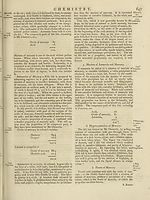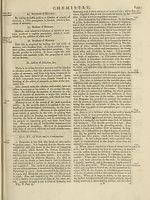Encyclopaedia Britannica, or, a Dictionary of arts, sciences, and miscellaneous literature : enlarged and improved. Illustrated with nearly six hundred engravings > Volume 5, BUR-CHI
(676) Page 648
Download files
Complete book:
Individual page:
Thumbnail gallery: Grid view | List view

648
Mercury,
See.
CHEMISTRY.
8. Borate of Mercury.
Boracic acid has no dir eft aft ion on mercury, but
by mixing together a folution of borate of foda with
a folution of nitrate of mercury, a yellowilh preci¬
pitate is obtained, which is the borate of mercury.
This fait acquires a greenilh colour by expofure to the
air. Lime water forms a precipitate of a red powder.
9. Phofphate of Mercury.
Phofphoric acid has no aftion on mercury, but it com¬
bines with its oxide. This fait may be prepared by
precipitating the nitrate of mercury in folution, by
means of phofphate of foda. A white precipitate is
formed, which is phofphate of mercury. I his fait is
infoluble in water, phofphorefces when rubbed in the
dark, and is decompofed by heat, giving out phofphoi
rus.
10. Carbonate of Mercury.
By precipitating the folutions of mercury in the
other acids by means of the alkaline carbonates, a
white precipitate is obtained, which is a carbonate of
mercury.
11. Arfeniate of Mercury.
When arfenic acid is diftilled in a retort with mer¬
cury, it is partially decompofed. Arfenious acid is
fublimed, with a portion of metallic mercury and a
fmall quantity of yellow oxide. There remains be¬
hind a yellow mafs, which is arfeniate of mercury. It
is infoluble in water, and in fulphuric and nitric acids.
It is foluble in muriatic acid, and affords by evapora¬
tion and fublimation, the muriate of mercury, or cor-
rofive fublimate. Arfenic acid precipitates the fulphate
and nitrate of mercury in the form of a white powder,
which is alfo arfeniate of mercury.
which enters into the combination. With the red-ox¬
ide of mercury it forms a fait which does not cryftal-
lize ; but when the liquid is concentrated, and evapo¬
rated to drynefs, it affords a yellow deliquefcent mafs.
When this fait is diffolved in water, it divides into
two parts j the one falls down in the ftate of yellow
powder, which is acetate of mercury with excefs of
bafe ; and the other part remains in folution, becaufe
it contains an excefs of acid.
2. But when nitrate of mercury is precipitated
by means of alkalies, and the precipitate is diffolved
in acetic acid, the folution yields by evaporation and
cooling, acetate of mercury, in thin brilliant flakes.
This fait may alfo be formed by mixing together folu¬
tions of acetate of potafh and nitrate of mercury.
The acetate of mercury appears in the form of large
flat cryftals, which have an acrid tafte, and are fcarce-
ly foluble in water. This latter fait is a compound of
acetic acid and the oxide of mercury, with a fmaller
proportion of oxygen. It is employed in medicine,
and forms the principal ingredient of Keyfer's pills.
17. Oxalate of Mercury.
Oxalic acid combines with the oxide of mercury,
and forms an oxalate in the ftate of white powder,
which is fcarcely foluble in water. It becomes black
by expofure to the light. When it is heated it detonates.
This fait may alfo be obtained, by adding oxalie
acid to a folution of the nitrate or fulphate of mer¬
cury.
18. Tartrate of Mercury.
Tartaric acid forms an infoluble fait of a white co¬
lour, with the oxide 'of mercury, which becomes yel¬
low' by expofure to the light.
19. Tartrate of Potalh and Mercury.
Mercury,
&c.
12. Tungftate of Mercury.
This fait is formed by adding to a folution of nitrate
»f mercury, an alkaline tungftate. This fait is decom¬
pofed, and the tungftate of mercury is precipitated in
the form of a white infoluble powder.
This triple fait may be prepared by boiling together
in water, one part of oxide of mercury, and fix of tar¬
tar. Cryftals of the triple fait are obtained by evapo¬
rating the liquid.
20. Citrate of Mercury.
13. Molybdate of Mercury.
Molybdic acid precipitates mercury from its folution
in nitric acid, in the form of a white flaky powder. It
is alfo infoluble in water.
Citric acid produces an effervefcence with the red
oxide of mercury, changes into a white colour, and
then unites it in one mafs. This fait is fcarcely folu¬
ble in water. It has a metallic tafte, and is decompo¬
fed by nitric acid.
14. Chromate of Mercury.
An alkaline chromate in folution, added to a folu¬
tion of nitrate of mercury, forms a precipitate of a
fine reddifh purple colour. This is the chromate of
mercury, which is infoluble in water, and which Vau-
quelin, who difeovered it, fuggefts to be employed as
a pigment.
15. Celumbate of Mercury.
Unknown.
16. Acetate of Mercury.
1)49 . . .
Cembines i. Acetic acid combines with^the oxides of mercu-
with two ry} and forms different (alts-, according to the oxide
21. Malate of Mercury.
When malic acid is added to a folution of nitrate of
mercury, a white precipitate is formed, which is ma¬
late of mercury.
22. Benzoate of Mercury.
Benzoic acid forms with the oxide of mercury, a
fait in the ftate of white powder, which is infoluble in
water, and is fcarcely altered by expofure to the air.
It is decompofed by heat.
23. Succinate of Mercury.
Succinic acid combines with the oxide of mercury
with the afliftance of heat, and forms with it an irre¬
gular mafs in which fome cryftals are obferved.
24. Saccolate
Mercury,
See.
CHEMISTRY.
8. Borate of Mercury.
Boracic acid has no dir eft aft ion on mercury, but
by mixing together a folution of borate of foda with
a folution of nitrate of mercury, a yellowilh preci¬
pitate is obtained, which is the borate of mercury.
This fait acquires a greenilh colour by expofure to the
air. Lime water forms a precipitate of a red powder.
9. Phofphate of Mercury.
Phofphoric acid has no aftion on mercury, but it com¬
bines with its oxide. This fait may be prepared by
precipitating the nitrate of mercury in folution, by
means of phofphate of foda. A white precipitate is
formed, which is phofphate of mercury. I his fait is
infoluble in water, phofphorefces when rubbed in the
dark, and is decompofed by heat, giving out phofphoi
rus.
10. Carbonate of Mercury.
By precipitating the folutions of mercury in the
other acids by means of the alkaline carbonates, a
white precipitate is obtained, which is a carbonate of
mercury.
11. Arfeniate of Mercury.
When arfenic acid is diftilled in a retort with mer¬
cury, it is partially decompofed. Arfenious acid is
fublimed, with a portion of metallic mercury and a
fmall quantity of yellow oxide. There remains be¬
hind a yellow mafs, which is arfeniate of mercury. It
is infoluble in water, and in fulphuric and nitric acids.
It is foluble in muriatic acid, and affords by evapora¬
tion and fublimation, the muriate of mercury, or cor-
rofive fublimate. Arfenic acid precipitates the fulphate
and nitrate of mercury in the form of a white powder,
which is alfo arfeniate of mercury.
which enters into the combination. With the red-ox¬
ide of mercury it forms a fait which does not cryftal-
lize ; but when the liquid is concentrated, and evapo¬
rated to drynefs, it affords a yellow deliquefcent mafs.
When this fait is diffolved in water, it divides into
two parts j the one falls down in the ftate of yellow
powder, which is acetate of mercury with excefs of
bafe ; and the other part remains in folution, becaufe
it contains an excefs of acid.
2. But when nitrate of mercury is precipitated
by means of alkalies, and the precipitate is diffolved
in acetic acid, the folution yields by evaporation and
cooling, acetate of mercury, in thin brilliant flakes.
This fait may alfo be formed by mixing together folu¬
tions of acetate of potafh and nitrate of mercury.
The acetate of mercury appears in the form of large
flat cryftals, which have an acrid tafte, and are fcarce-
ly foluble in water. This latter fait is a compound of
acetic acid and the oxide of mercury, with a fmaller
proportion of oxygen. It is employed in medicine,
and forms the principal ingredient of Keyfer's pills.
17. Oxalate of Mercury.
Oxalic acid combines with the oxide of mercury,
and forms an oxalate in the ftate of white powder,
which is fcarcely foluble in water. It becomes black
by expofure to the light. When it is heated it detonates.
This fait may alfo be obtained, by adding oxalie
acid to a folution of the nitrate or fulphate of mer¬
cury.
18. Tartrate of Mercury.
Tartaric acid forms an infoluble fait of a white co¬
lour, with the oxide 'of mercury, which becomes yel¬
low' by expofure to the light.
19. Tartrate of Potalh and Mercury.
Mercury,
&c.
12. Tungftate of Mercury.
This fait is formed by adding to a folution of nitrate
»f mercury, an alkaline tungftate. This fait is decom¬
pofed, and the tungftate of mercury is precipitated in
the form of a white infoluble powder.
This triple fait may be prepared by boiling together
in water, one part of oxide of mercury, and fix of tar¬
tar. Cryftals of the triple fait are obtained by evapo¬
rating the liquid.
20. Citrate of Mercury.
13. Molybdate of Mercury.
Molybdic acid precipitates mercury from its folution
in nitric acid, in the form of a white flaky powder. It
is alfo infoluble in water.
Citric acid produces an effervefcence with the red
oxide of mercury, changes into a white colour, and
then unites it in one mafs. This fait is fcarcely folu¬
ble in water. It has a metallic tafte, and is decompo¬
fed by nitric acid.
14. Chromate of Mercury.
An alkaline chromate in folution, added to a folu¬
tion of nitrate of mercury, forms a precipitate of a
fine reddifh purple colour. This is the chromate of
mercury, which is infoluble in water, and which Vau-
quelin, who difeovered it, fuggefts to be employed as
a pigment.
15. Celumbate of Mercury.
Unknown.
16. Acetate of Mercury.
1)49 . . .
Cembines i. Acetic acid combines with^the oxides of mercu-
with two ry} and forms different (alts-, according to the oxide
21. Malate of Mercury.
When malic acid is added to a folution of nitrate of
mercury, a white precipitate is formed, which is ma¬
late of mercury.
22. Benzoate of Mercury.
Benzoic acid forms with the oxide of mercury, a
fait in the ftate of white powder, which is infoluble in
water, and is fcarcely altered by expofure to the air.
It is decompofed by heat.
23. Succinate of Mercury.
Succinic acid combines with the oxide of mercury
with the afliftance of heat, and forms with it an irre¬
gular mafs in which fome cryftals are obferved.
24. Saccolate
Set display mode to:
![]() Universal Viewer |
Universal Viewer | ![]() Mirador |
Large image | Transcription
Mirador |
Large image | Transcription
Images and transcriptions on this page, including medium image downloads, may be used under the Creative Commons Attribution 4.0 International Licence unless otherwise stated. ![]()
| Permanent URL | https://digital.nls.uk/192993057 |
|---|
| Attribution and copyright: |
|
|---|
| Description | Ten editions of 'Encyclopaedia Britannica', issued from 1768-1903, in 231 volumes. Originally issued in 100 weekly parts (3 volumes) between 1768 and 1771 by publishers: Colin Macfarquhar and Andrew Bell (Edinburgh); editor: William Smellie: engraver: Andrew Bell. Expanded editions in the 19th century featured more volumes and contributions from leading experts in their fields. Managed and published in Edinburgh up to the 9th edition (25 volumes, from 1875-1889); the 10th edition (1902-1903) re-issued the 9th edition, with 11 supplementary volumes. |
|---|---|
| Additional NLS resources: |
|

